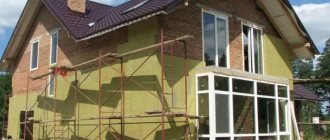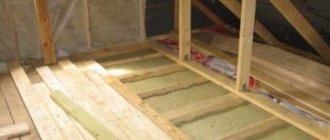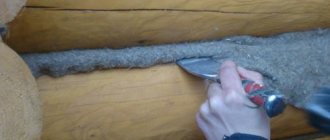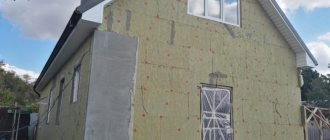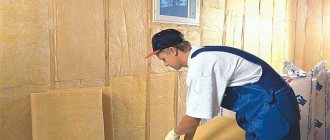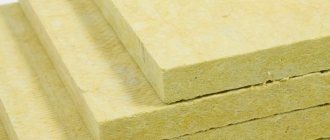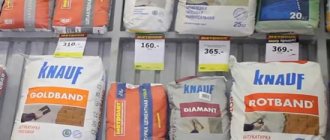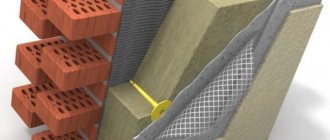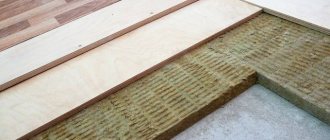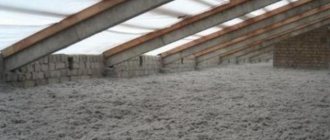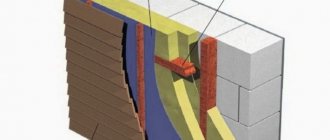The under-roof space is used in different ways; living rooms or storage systems are equipped here. Thermal insulation work, which requires little labor and financial investment, makes it possible to get additional living space that will never be superfluous. More than half of developers use mineral wool as a thermal insulator. Let's talk about the process of insulating an attic from the inside with your own hands using mineral wool, and the video at the end of the article will help you better understand this issue.
Mineral wool: definition and manufacturing technology
Among the existing methods of insulating an attic from the inside, mineral wool comes first as an economically advantageous and technically convenient material. Its price is significantly lower than other insulation materials, and installation is easy and simple.
Mineral wool is a reliable insulation material
Mineral wool is fiber obtained from the melt of volcanic rocks, waste from glass and blast furnace production. Depending on the base, insulation is divided into basalt, slag or glass wool.
*
Types of mineral wool insulation
To obtain it, the same technology is used:
- Glass, molten rock or blast furnace slag is loaded into a shaft-type furnace.
- At temperatures above 1500ºС they are heated to a liquid state. Fibers are obtained directly by blowing or centrifugal method. They make up the structure of the material.
- The fibers are bonded with phenol-formaldehyde resins followed by polymerization.
- Heat treatment.
- Package.
Technological scheme for obtaining mineral wool
*
Mineral wool is hygroscopic; with prolonged contact with water, it loses its thermal insulation properties. To prevent moisture from entering, the material is sealed in plastic film.
Advantages and disadvantages of mineral wool
Advantages and disadvantages of mineral wool
After heat treatment, mineral wool acquires the following qualities:
- low heat conductivity, which makes mineral wool an excellent insulation material;
- fire safety, the production of wool from non-flammable components allows it to resist fire;
- resistance to various temperature conditions, sudden changes do not cause deformation of the insulation;
- resistance to chemically aggressive environments;
- the ability to resist the appearance and development of microorganisms inside the insulation;
- excellent vapor permeability;
- ease of installation.
Among the disadvantages are excessive hygroscopicity and a tendency to form dust. The last property appears only during work. Compliance with all safety regulations during installation work helps to avoid the appearance of dust.
Preparatory stage
Insulating the attic from the inside with thermal insulation material - mineral wool - begins with preparatory measures.
Preparing for insulation
Preliminary work:
- Inspection of surfaces for fixing mineral wool.
- Coating wooden surfaces with an antiseptic, and metal with anti-corrosion compounds.
- Replacing damaged areas, drying damp areas.
- Inspection of the rafter system and repair.
- Removing the packaging film from the cotton wool so that the material takes on the desired shape.
- Preparation of protective clothing for safe installation: suit, gloves, respirator, goggles.
Manual calculation
The next step in insulating a cold attic of a house with mineral wool is calculating the thickness of the layer.
Errors when choosing the thickness of the mineral wool layer
*
Manual calculations are carried out in accordance with the set of rules “Thermal protection of buildings”. The given formulas and calculations will require special training from a non-specialist.
It is impractical to understand the nuances of manual technology for calculating one individual attic. It is recommended to use free calculator programs from the Internet.
Final recommendations
Now you know the answer to the question of how to insulate an attic from the inside with your own hands.
In conclusion, it is worth noting that these works, if necessary, are combined with insulation of the walls and gables of the attic.
In particular, such a need arises in the absence of the possibility of external insulation or errors in carrying out such work (namely, insufficient thickness of the facade thermal insulation).
For internal insulation of vertical attic structures, breathable materials such as mineral wool or ecowool are best suited; in order to save effort and time, all work is carried out in a complex.
The effect of their implementation needs to be checked; in the first winter, all attic structures are periodically inspected using a thermal imager.
Features of insulation
Nuances taken into account when insulating
Before starting work on laying thermal insulation material, pay attention to the following important features of insulation:
- The attic will be a living space, and therefore will require more thorough thermal insulation than roof insulation.
- The rafter system and floors are not designed for great forces, so the insulation should have a small mass. Taking into account the specific gravity, mineral wool is ideal.
- Heat leaves the attic not only through the roof, but also through the walls and floor; they also require careful insulation.
- Warm air, due to its physical characteristics, promotes the formation of dew drops, so the thermal insulation layer should be covered with a vapor-proof film.
Which mineral wool is best for the attic
According to experts in the field of private housing construction, mineral wool is considered the best thermal insulation material.
In order to verify this, we will perform a comparative analysis of cotton insulation on different bases.
Slag wool was popular in the former USSR more than 30 years ago. Its disadvantage is its high hygroscopicity. This quality is unacceptable in insulation for rooms with high humidity. Modern builders prefer modern glass and basalt products.
Comparison of mineral wool on different basis
*
On the Russian market we can distinguish the TOP of 7 manufacturers whose high quality products best correspond to the price:
Rockwool basalt wool
The leader is the Danish company Rockwool, which produces basalt-based thermal insulation. According to reviews from builders, it maintains a high standard of 10 points out of 10 possible, and ensures maximum quality without unnecessary unjustified overpayments.
Paroc basalt wool
Three companies occupy second place. Their performance is 9.9 out of 10:
- Paroc is a manufacturer of basalt mineral wool from Finland. His rating is 9.9 out of 10.
Mineral wool ISOVER
- The French concern Saint-Gobain is an international concern. He began producing his own thermal insulation materials 80 years ago. Products are manufactured based on glass and basalt rocks.
Mineral wool Knauf
The German group of companies Knauf produces insulation from glass and stone fibers.
Glass wool URSA
An international company from Spain, URSA, was formed relatively recently, after the URALITA Group concern acquired the German company Pfleiderer, or rather, its insulation business. Mineral wool is made from glass. Factories are scattered throughout Europe, and there is a representative office in Russia. The company's rating is 9.8 out of 10.
TechnoNIKOL basalt wool
The TOP is completed by two companies TechnoNIKOL from Russia and Beltep from Belarus. Their products are made from volcanic rocks and are of high quality and reasonable prices. Rating indicators 9.5 out of 10.
Beltep basalt wool
Having become familiar with the best mineral wool manufacturers, the builder makes his own choice. There is no consensus which of the listed brands is the best. When choosing, take into account the structural features of the roof, the climatic conditions of the region and the price.
Choosing insulation for an attic roof
If you are insulating a room yourself, then one of the most difficult tasks is choosing insulation. There is such a huge range of types and brands of materials on the building materials market that you simply get lost.
When I decided to insulate the attic, I had a choice between polystyrene foam and mineral wool. However, it turned out that there are many more insulating materials, and each has its own pros and cons.
A master builder with 20 years of experience advised me to choose insulation for the attic for winter living in accordance with the following requirements:
- thermal conductivity coefficient no more than 0.04 W/mS;
- noise absorption coefficient from 0 to 1;
- vapor permeability not higher than 0.5 mg/(m*h*Pa);
- fire safety class NG or G1;
- load reliability factor is about 1.3 Yf;
- environmental safety close to class A;
- efficiency;
- no difficulties during installation.
Below we will consider in detail which insulation materials meet these requirements.
Styrofoam
Polystyrene foam is made by foaming polymers. The bulk of polystyrene foam consists of air, so it has low weight and good thermal insulation properties. The positive qualities include moisture resistance, excellent sound insulation and low cost.
Foam plastic retains its performance properties in a fairly wide range from -50 to +75 °C. There are no problems when working with it. Polystyrene foam can be easily cut with a knife, and it can be attached to the surface using glue.
Disadvantages include the fragility of the material. During the cutting process, the edges of the foam crumble, so there are gaps at the joints where cold bridges can form. The main disadvantage of polystyrene foam is its high flammability, so it cannot be used in areas with a high fire hazard.
Extruded polystyrene foam
During the production process, expanded polystyrene is subjected to high-temperature treatment, due to which, despite the small thickness of the material, it has high heat-shielding properties and good strength. With all the positive properties, the material also has disadvantages. The cost of this insulation is approximately 2 times higher than the cost of polystyrene foam. The material is made from plastic, so it cannot be called environmentally friendly.
Although manufacturers claim that polystyrene foam is resistant to fire, practice shows the opposite. As for sound insulation, compared to polystyrene foam and mineral wool, polystyrene foam has lower performance.
Mineral wool
Mineral wool has a fibrous structure and is available in rolls and mats. It is made from natural ingredients with a small amount of synthetic binders, and therefore is highly environmentally friendly.
It has high heat-protective and sound-proofing qualities. This is especially important if there is a bedroom in the attic. Agree, it’s difficult to sleep when rain is drumming on the roof. Insulating the roof with mineral wool solves this problem.
Mineral wool is not afraid of fire and high temperatures, melts only at a temperature of 1000 °C, so it is often chosen for insulating wooden houses. It is highly resistant to temperature changes and chemicals. At the same time, the material has a low cost, on average about 600 rubles per square meter. m.
The main disadvantage of mineral wool is its increased hygroscopicity, so it requires mandatory waterproofing.
Hygroscopicity is the ability of insulation to absorb moisture from the environment.
Glass wool
Glass wool is a type of mineral wool. Its difference lies in its production technology; it is made from molten glass. It has the same pros and cons as mineral wool.
Stone wool
Basalt, or stone wool, is made from molten rocks. It is also a derivative of mineral wool, and therefore has the same qualities as the previous two.
Ecowool
Ecowool is a relatively new type of insulation, which is made from cellulose waste. The material consists of 80% loose paper fiber, the remaining 12% is a natural antiseptic boric acid and 8% is borax, which is added to reduce the attractiveness of ecowool for insects and rodents.
Ecowool has low water permeability and a high degree of sound insulation due to hollow holes in the insulation fibers, which absorb sound and do not allow moisture to pass through. Since synthetic materials are not used in the production of ecowool, it is environmentally friendly.
The level of thermal protection of ecowool is approximately the same as that of mineral wool. When wet, the insulation does not lose its protective properties. Has good adhesion to almost any material.
The disadvantages include low rigidity, which requires the installation of additional supporting structures. The material has a high shrinkage (after 2 years it sags significantly), so experts recommend increasing the ecowool layer during installation by 30% of the calculated value.
Ecowool, although it does not burn, does smolder, so it cannot be called completely fireproof. The relatively low price of the material (from 50 rubles per kg) is offset by the high cost of installation. For work on ecowool insulation, specialists charge from 1000 rubles per 1 sq. m. m. Without special additional equipment, it will not be possible to insulate the attic with ecowool yourself.
Polyurethane foam
Polyurethane foam is a sprayed insulation material, it is obtained by the synthesis of two components: a polyol and a polyisocyanate. During the reaction, carbon dioxide is intensively released, resulting in a foamed, dense insulating material.
Thanks to its dense porous texture, it provides good thermal protection. For comparison: the thermal conductivity of polyurethane foam is 0.02 W/m, and that of mineral wool is 0.05 W/m. PPU has higher sound insulation rates compared to other insulation materials, as it has a higher density and cellular structure.
Due to the continuous application there are no joints, so cold bridges do not form in it. Using polyurethane foam you can insulate the most complex structures and shapes.
The insulation has excellent adhesion to all types of materials, except polyethylene. It is a non-combustible material and is a leader among other insulation materials in terms of moisture resistance. It has high performance properties and can withstand temperatures ranging from -160… +150 °C.
The downside is the labor-intensive installation technology, which does not allow you to do the work yourself. Insulation requires specialized installation equipment and is expensive. Application with a layer of 15 cm will cost you from 1200 rubles/sq.m. m.
Since polyurethane foam is a vapor-proof material, an attic insulated with it will need forced ventilation.
Penofol
The insulation consists of foamed polyethylene, covered on one or both sides with aluminum foil. Penofol is popular because with a small thickness of the material - from 2 mm to 4 cm - it has high heat-protective, vapor barrier and noise-reducing properties.
Aluminum foil covering penofol reflects thermal radiation, while polyethylene foam, on the contrary, absorbs thermal energy. This combined technology allows you to reliably insulate the room. Aluminum foil and polyethylene foam have a vapor permeability below 0.001 mg/(m*h*Pa), so it reliably protects the structure from evaporation.
The insulation does not require additional waterproofing. It is light in weight, easy to cut with a knife and easy to install. Environmentally friendly. Penofol is a highly flammable material. The average price for penofol is about 100 rubles/sq.m. m.
Among the disadvantages, it is worth noting the low rigidity of the material, so it will not be possible to apply finishing materials directly to it. Penofol should be used carefully in places where electrical wires and equipment come into contact, as it is a conductor of electricity.
Properties and features of mineral wool cladding
*
Mandatory requirement: when insulating, the insulating material should be laid in two layers. This design most closely matches the thickness of the rafter system and provides better thermal insulation for the attic. It will be warm here in winter and cool in summer.
Roofing pie
Insulation of the attic from the roof side is carried out according to the following scheme:
- slate or metal tiles;
- sheathing;
- roofing felt as a waterproofing material;
- mineral wool insulation;
- vapor barrier film.
Roofing pie composition
External roof insulation of an attic has few differences from the internal method of thermal insulation. The only difference is that before installing the mineral insulation, the inside of the roof remains bare.
Option with a residential attic
If the space under the roof allows you to equip an additional living room in this place, then the owners of private houses almost always take advantage of this advantage. A popular option is the vertical arrangement of the attic walls.
Vertical arrangement of the partition
Firstly, this allows you to increase the usable area, and secondly, it is possible to create a better thermal insulation cake. But more often there are sloping walls repeating the slope of the roof. With this method, external laying of insulation is used.
When insulating an attic internally, the following pie is used:
- A vapor barrier is laid on the sheathing.
- The second layer is laid mineral sheets, the thickness of which corresponds to the climatic conditions of the region.
- Next, the slats are filled horizontally, and the last 50 mm layer of thermal insulation is laid on top.
- At the final stage, a vapor barrier layer is filled.
Important! To reduce pressure from air flows, it is recommended to stuff slats over the vapor barrier.
What to pay attention to
When positioned vertically, there is free space between the roof and walls that needs to be insulated. In this case, the vapor barrier is installed from the roof side and on vertical structures. You should not ignore the installation of insulation on this section of the roof. If neglected, the indoor temperature may decrease or heating costs may increase.
Space behind the wall
Since cotton wool is afraid of high humidity, it needs enhanced protection. To do this, a vapor barrier is laid on both sides of the thermal insulation cake. Builders recommend using an auxiliary layer of polystyrene foam insulation. It will create a repulsive obstacle to a humid environment, preserving the quality of the mineral wool.
Materials and tools necessary for insulating the attic
If mineral wool is chosen as the thermal insulation material, and you plan to do the insulation process yourself, then you cannot do without special tools and materials:
- glass or basalt wool;
- waterproofing film;
- vapor barrier fabric;
- wooden planks;
- timber 50×50, maybe less, but not less than 25×25;
- plane;
- axe;
- chisel;
- hammer;
- stationery knife;
- stapler;
- marker;
- measuring instrument;
- fastener
Laying the base for finishing.
For the inner lining of the attic, you can choose OSB sheets, lining, plywood or plasterboard. If you installed an additional beam for thermal insulation, nail the sheathing close to the beam. If there is no timber, we recommend using slats to make a gap of at least 20 mm and install the sheathing.
The warm attic is ready! Now your home is reliably protected from cold and heat, and there is much more space.
Algorithm for insulating the roof and walls of the attic: step-by-step instructions
*
Checking the evenness of rafter legs
- Before starting work, check the levelness of the rafter legs. This can be done using a long building level.
Measuring the distance between rafters
- Measuring the inter-rafter distance. It should be a multiple of 58 or 118 cm. Ideal option: maintain this size at the stage of design and construction of the roof. In this case, you can use standard mineral wool slabs with a width of 60 cm. The distance of 58 cm is calculated for one slab, which will simplify its fastening. A margin of 2 cm will allow the plate to be installed in the spacer and held in place without additional fasteners. This scheme will help to avoid gaps between beams and insulation slabs.
Fixing the insulation
- If the distance does not correspond to the specified dimensions, then the slabs are held in place with synthetic twine and counter-lattice. When cutting the material, a margin of 2 cm is provided.
Installation of a waterproofing layer
- Insulation of an attic roof begins with the creation of a waterproofing layer. A special film is used as a hydrobarrier. It is secured along the rafters with planks so that it envelops the frame beams.
Installation of insulation boards
- Installation of mineral wool slabs occurs by compressing them and installing them in the space between the rafters. To avoid the formation of cold bridges, the insulation is laid in two layers. Each layer of mineral wool is secured with synthetic twine. Horizontal and vertical seams are staggered. It is important to prevent creases and wrinkles on the surface of the insulation. Where roof windows are installed, pay attention to the quality of the mineral wool laid. Here you need to use non-standard pieces of insulation and mount them along the frame.
- They begin to insulate the end walls of the attic. A frame with a distance between posts of 58 or 118 cm is installed on the gables. In order to save time and get an accurate result, the thickness of the insulation for the walls is calculated using a calculator program. This will save time and give an accurate result.
- After the insulation is installed, you need to check the presence of all places where cold bridges can form. To insulate them, sealant or polyurethane foam is used. Particular attention is paid to the joints between the outer rafters and the wall.
Vapor barrier membrane fastening
- Installation of a vapor barrier layer. For insulation, you can use polyethylene film, but it is better to use a vapor barrier membrane. It will protect the insulation from condensation and will not interfere with air exchange in the room.
Gluing the vapor barrier with special tape
- For fastening to the rafters, a construction stapler and staples are used. The fastening pitch is 150-200 mm. The membrane is overlapped with a margin of 100-150 mm. After installation, all joints are carefully taped with a special tape; it will provide maximum protection of the insulation from steam.
Installation of lathing for finishing
- The bottom sheathing is made of 50×50 timber; it will hold the insulation in its original position and will serve as the basis for attaching the ceiling and wall sheathing.
A detailed article about insulating a frame house with mineral wool.
What is more convenient: rolls or mats?
In fact, in what form this or that insulation is sold plays a big role for many ordinary people. Some people prefer to work only with slabs as they are more convenient, but for the majority, rolls seem rational: rolled out and secured, what could be simpler?
Roll material is really convenient to work with. They rolled it out to the required length, cut it, and rolled the cut piece. They brought a new skein to the right place, rolled it out again, straightened it and secured it. Roll insulation is also convenient because, with a standard distance between rafters of 61 cm, the roll can be easily cut in half with a regular knife, and its halves will fit perfectly into their niches - just roll them out:
Less convenient in practice for many is the packaging of rectangular slabs, which leaves the most waste. But it is easier to transport, and the insulation in it does not bend, like in a roll, which is a critical issue for many materials:
And finally: when buying insulation, be sure to pay close attention to the integrity of the packaging, otherwise you won’t end up with problems later. The insulation packaging must be completely sealed, slightly compressed, without a single scratch or torn film. This is the only way to prevent moisture from getting to the insulation before installation begins.
Now imagine what happens to insulation in poor-quality packaging: moisture and water vapor penetrate the material through holes and slits, the insulation gets wet in places and changes its geometry and properties. On site, you unpack the roll or slabs and begin installation, and then it turns out that the insulation, swollen and heavy in places, does not fit together in any way, the cracks are visible even to the naked eye. Having somehow suffered, you cover all this stuff with clapboard or drywall. As a result, undried insulation ends up in a closed and dark space - an ideal place for mold to grow. The consequences are usually not at all pleasing to the eye, and you will recognize their presence by the unpleasant smell within a few weeks.
Therefore, follow our recommendations, study our website - and you can avoid problems.
Insulating the ceiling of a cold attic of a house with rolled mineral wool
Pie of the attic floor
Insulating the attic floor with mineral wool is done in the same way as with wall cladding. It happens in two layers, but the algorithm for performing the work is different.
Stages of insulating the attic floor with mineral wool:
- Attaching the vapor barrier membrane.
- Insulation of the attic floor on wooden beams with rolled mineral wool.
- The final stage of insulating the attic floor is attaching the water barrier. You can use roofing felt, plastic film or a vapor barrier membrane.
The above recommendations will help even a novice builder to insulate an attic with mineral wool. As a result, the usable area of the house will almost double.
